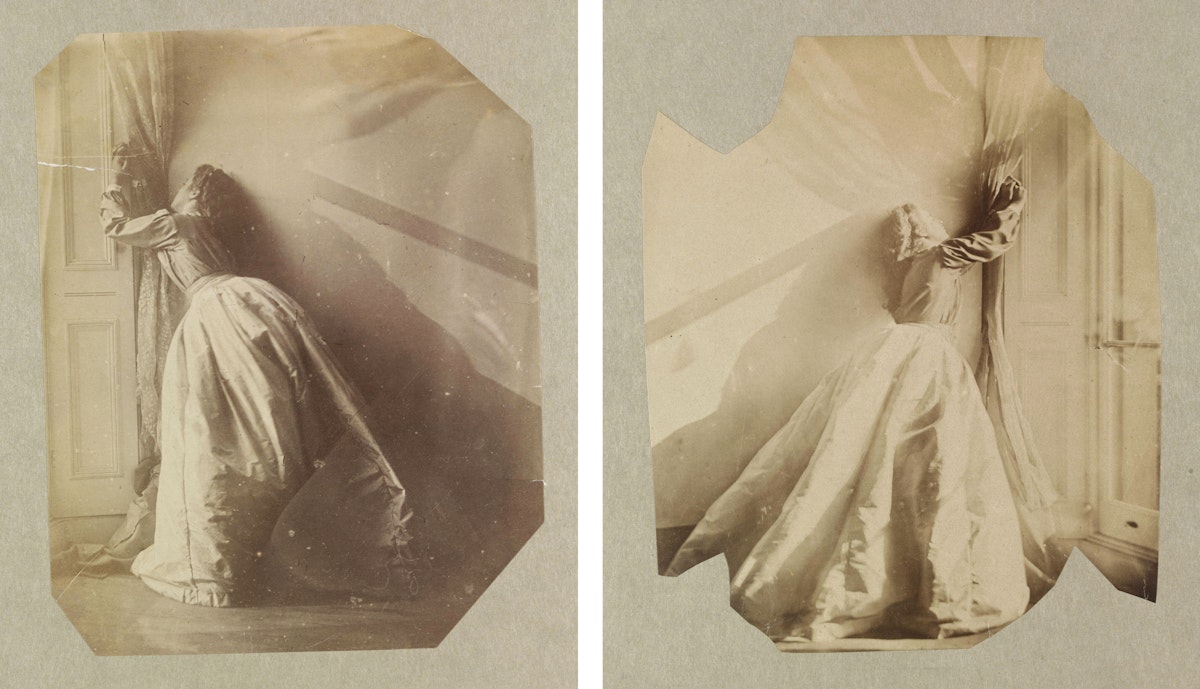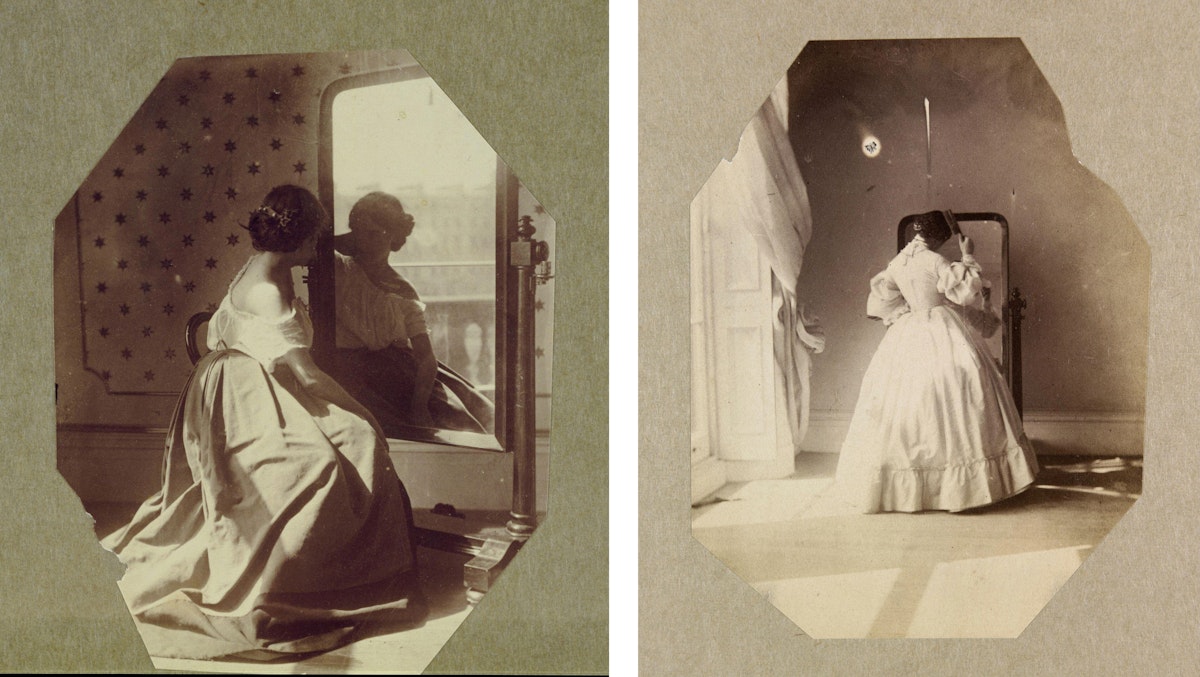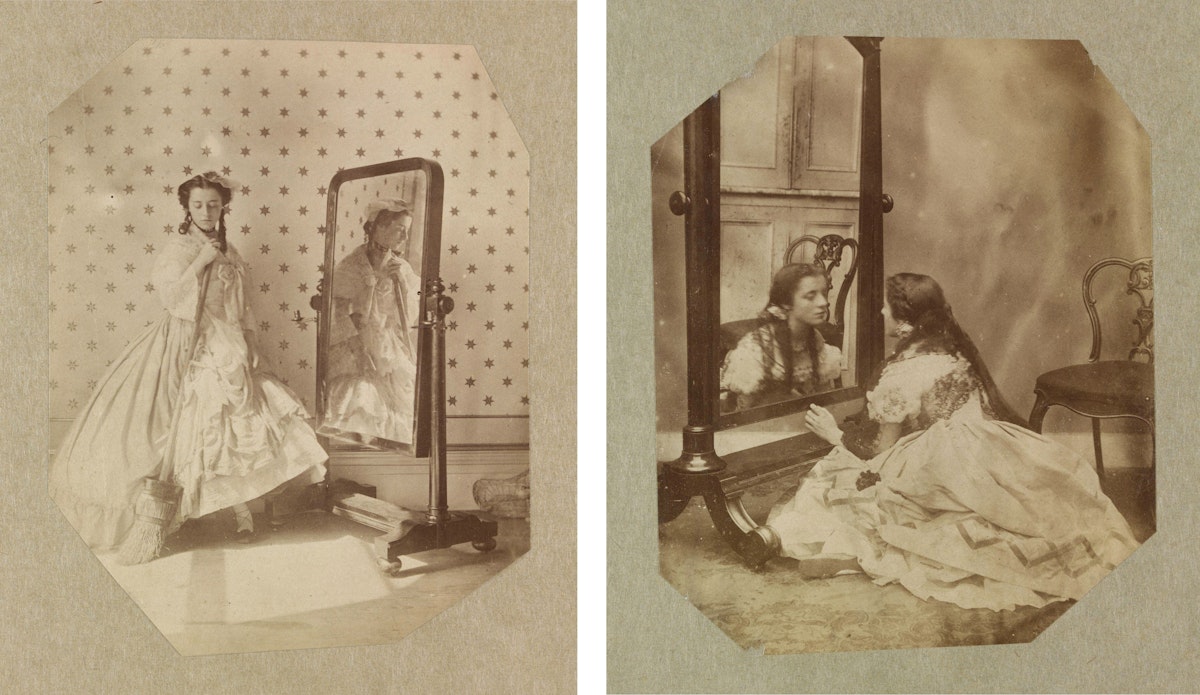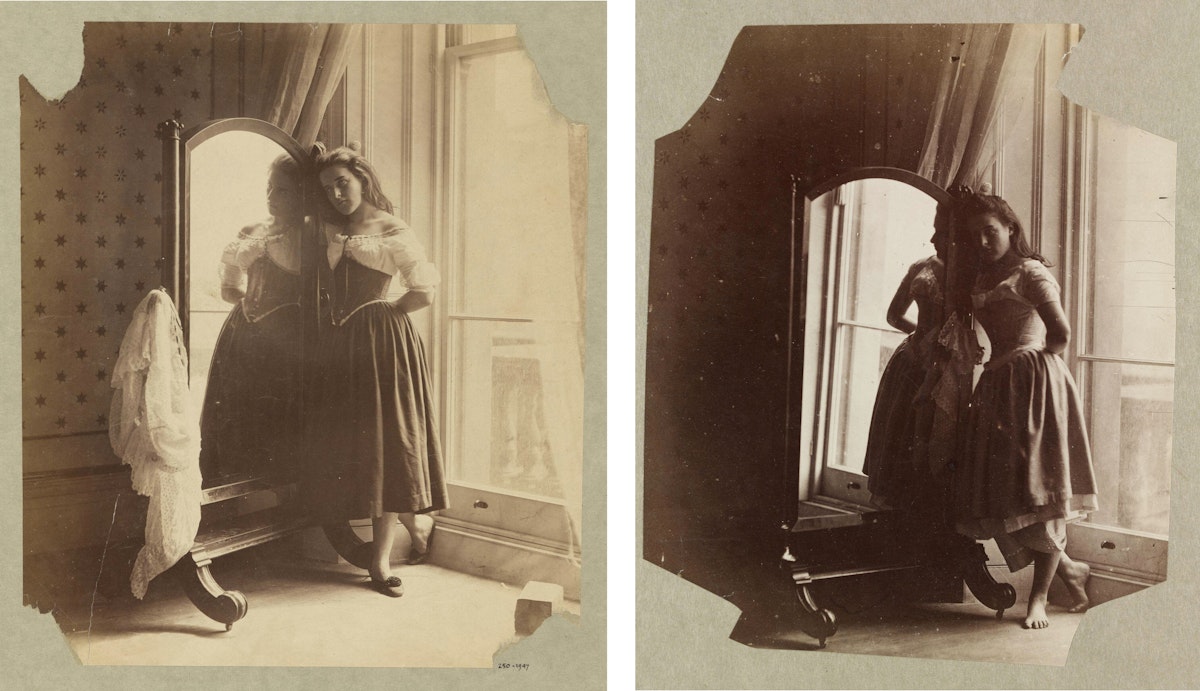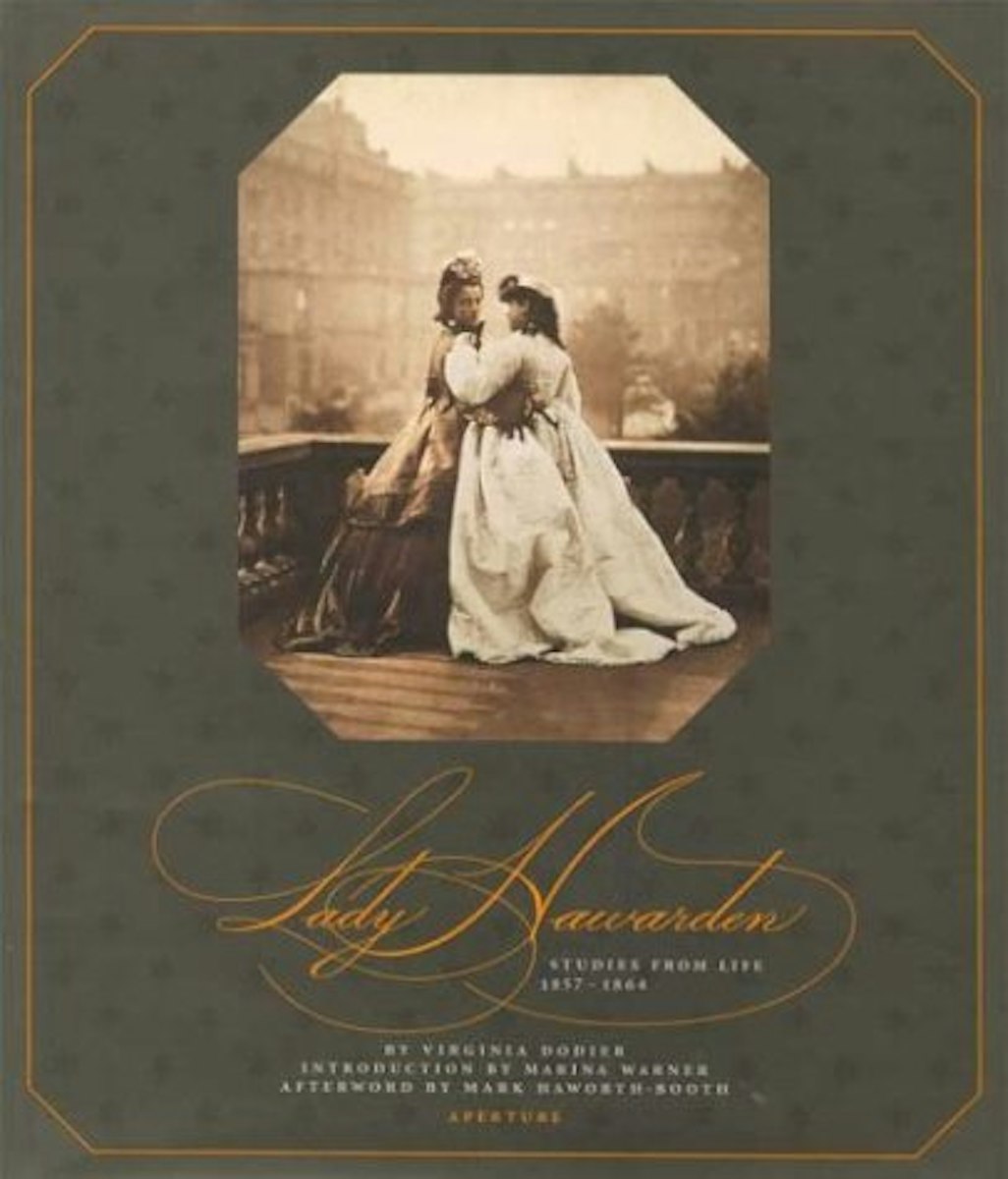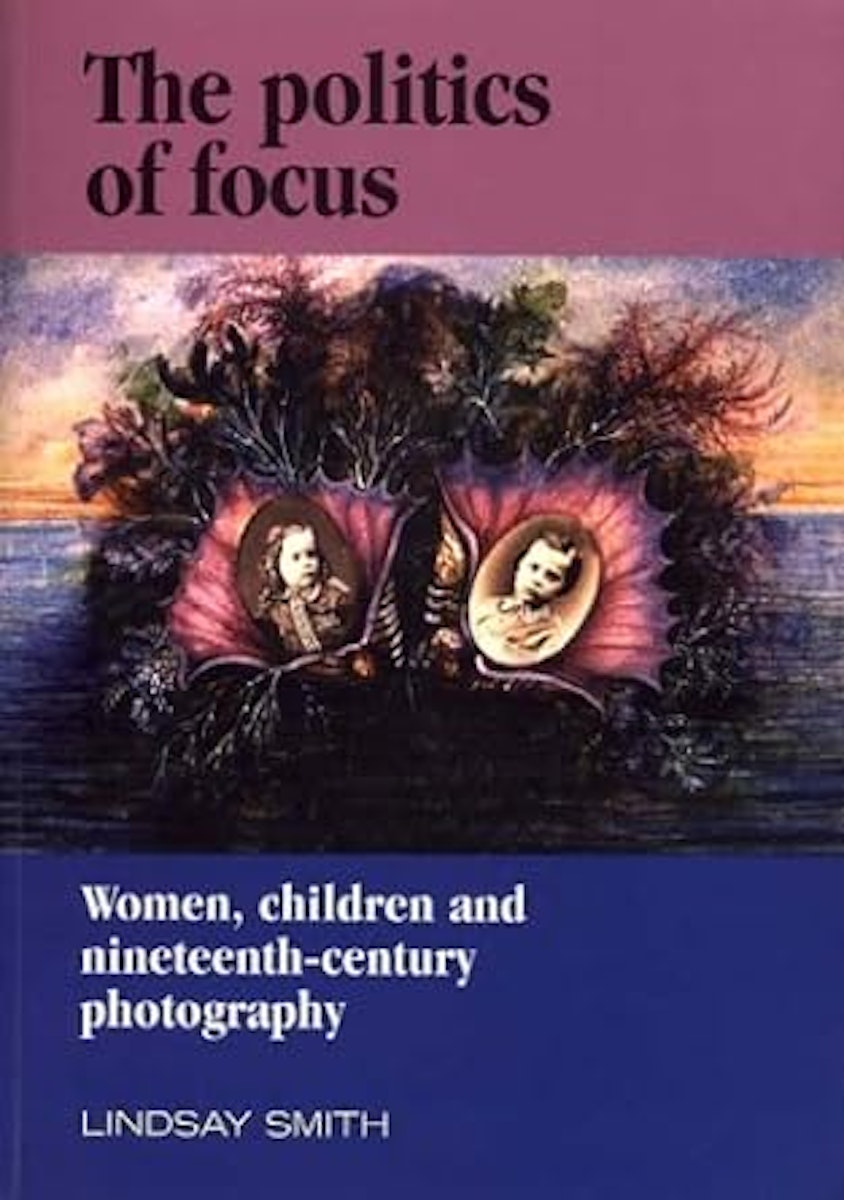
Through the Cheval Glass Reproduction in the Photographs of Clementina Hawarden
Soon after Clementina Hawarden began taking photographs in the mid-19th century, her eye caught on doubles, reflections, her daughters glimpsed in the mirror. Stassa Edwards examines the role that reproduction — photographic, biological — plays in this oeuvre, and searches for the only person not captured clearly: Hawarden herself.
January 24, 2024
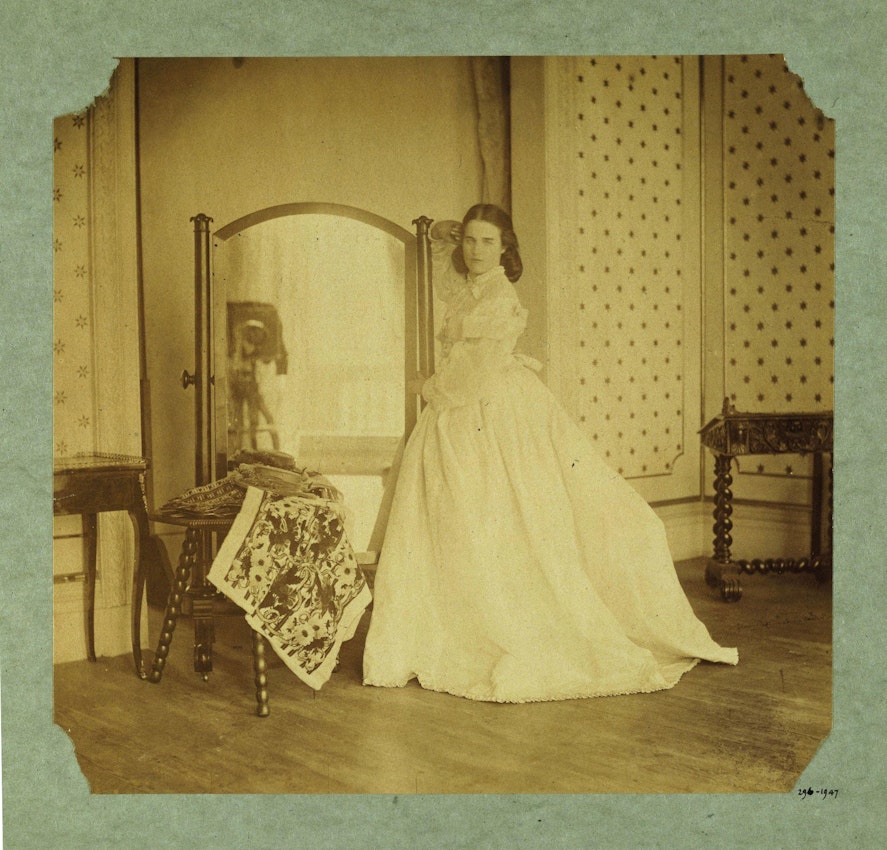 Scroll through the whole page to download all images before printing.
Scroll through the whole page to download all images before printing.Photograph by Clementina Hawarden of her daughter, also named Clementina, taken in her home studio at 5 Princes Gardens in South Kensington, London, ca. 1862–63. The Victoria & Albert Museum’s description of this photograph conjectures that “possibly there is a slight suggestion of a hand in the act of removing and/or replacing the lens cap to begin and end the exposure” — Source.
Does Lady Clementina Hawarden’s hand hover, disembodied, next to her camera in this photograph? It seems to exist in an indeterminate state. At once present and absent, her hand is, as the Victoria & Albert’s labeling indicates, a “slight suggestion”, a blurred historical reproduction or a trick of the present-day viewer’s eyes, as they produce the history we want to see.
This ghostly outline appears in one of the many photographs Hawarden took of her daughter Clementina, who wears a typically fussy Victorian dress, her right forearm leaning against a large mirror, fingers grazing her temple. Clementina’s contemplative pose frames the full-length mirror, demanding that the viewer’s gaze linger on both the reflective object and what is or is not captured in it. It is an unusual image: though roughly 775 of her photographs survive, this ghostly remnant is one of only two possible photographic traces left of the viscountess.
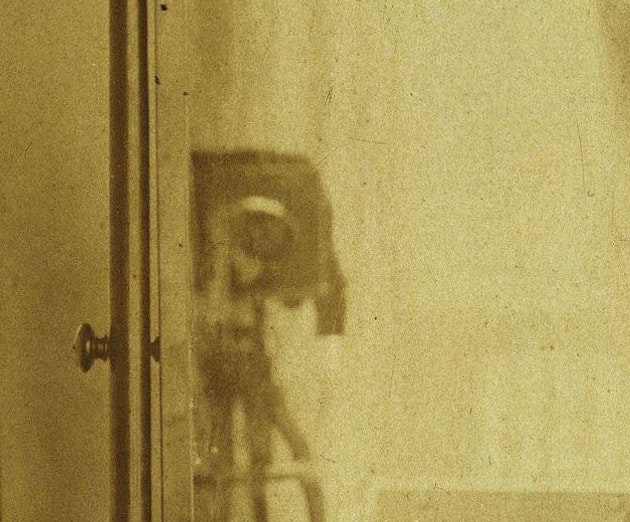 Scroll through the whole page to download all images before printing.
Scroll through the whole page to download all images before printing.Detail of the camera reflected in a mirror from Clementina Hawarden’s photograph of her daughter Clementina, ca. 1862–63. The “suggestion of a hand” is supposedly visible here on the left side of the camera, wrapping the lens — Source.
In this accidental (or apocryphal) self-portrait, taken between 1859 and 1861, one can see a confluence of various forms of reproduction: that of biology, in the subject of her daughter, and that of the visual, in the technology of photography and the reflecting mirror. Hawarden is the source of this reproduction — creator of both the photograph and her daughter; her “authorship” is underscored by the placement of her camera in the mirror, and made uncanny by her spectral presence, real or imagined. The full-length mirror appeared regularly in Hawarden’s photographs, emerging as one of her favorite props in the makeshift studio she created in her South Kensington, London home located at 5 Princes Gardens.1 Within the frame of the photograph, the labor of motherhood and the labor of photography are compositionally bound by mirror-adjacent effects: doubling and reproduction, a rare coupling by one of early photography’s rare woman practitioners.
If Hawarden’s “self-portrait” is nothing but a faint suggestion, then so is the surviving knowledge of the viscountess herself: In both official records and sparse family letters, she is little more than a ghostly impression. Few letters by her hand survive and there are no extant records of her social life as a member of the Victorian elite. Letters written by various family members are unsurprisingly focused on “Clemy’s” domestic life, particularly mothering, work that would have undoubtedly consumed the majority of her time. On her photography, the historical record is silent. As far as we know, she left no letters or diaries that shed light on her artistic practice. If she ever titled her photographs or depicted scenes from certain works of literature or art, those have been lost to time (the few photographs she exhibited were simply titled Photographic Studies or Studies from My Life). With what little that survives, the photographs are the only tangible material trace left of Hawarden; part of their allure is not simply their beauty or formal mastery but their mysteriousness. That is true of Hawarden, too: she is unknowable, little more than a spectral presence that haunts her work — a presence presumed rather than seen.
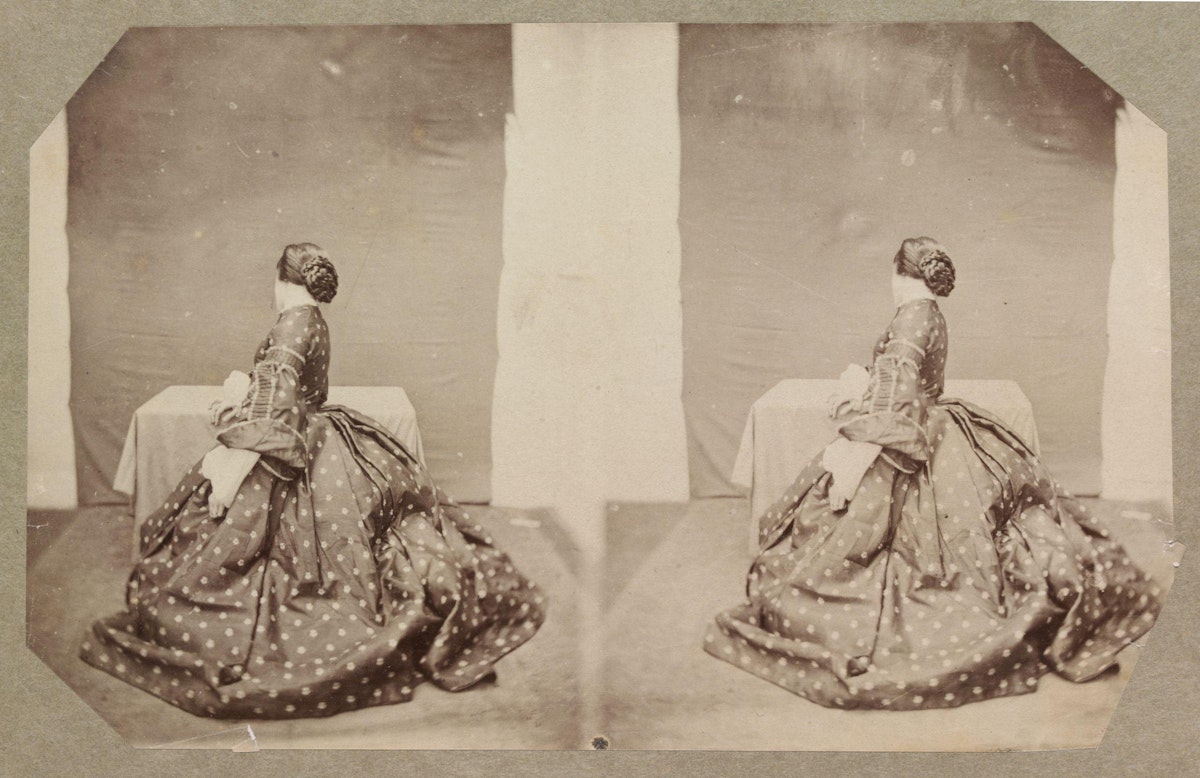 Scroll through the whole page to download all images before printing.
Scroll through the whole page to download all images before printing.Stereograph by Clementina Hawarden of her daughter Isabella Grace posing in profil perdu (lost profile), ca. 1859–61— Source.
Before Hawarden was a ghost she was a girl. The daughter of a Navy admiral and a Spanish woman regarded for her beauty, Hawarden’s (née Fleeming) childhood was unremarkable. Virginia Dodier recounts that Hawarden and her sisters were “trained and encouraged in what is now termed ‘accomplishment art,’ the type of arts education then available to young girls of the middle and upper classes.”2 After some obligatory time on the continent, she returned to London and met her future husband. At twenty-three years old, she married Cornwallis Maude, the future fourth Viscount Hawarden, significantly elevating her social status if not her immediate financial status. Hawarden’s in-laws objected to the match. Her cousin, John, 13th Lord of Elphinstone, described the situation in an 1845 letter: “Poor Clemy!” he wrote, “I hope she will be happy, but it is a sad thing to marry into a family that is unwilling to receive you–& it requires a great deal of love on the part of the husband to make up for the want of it in the others”.3
Despite the disapproval, Hawarden understood that her primary occupation as a future viscountess was to produce an heir, a job she undertook with enthusiasm. Between 1846 and her death, aged forty-two, in early 1865, Hawarden gave birth to ten children, eight of whom lived to adulthood and one of whom had the good sense to be a boy.4 Her three eldest daughters, Isabella, Clementina, and Florence, became her most familiar models, assisting their mother in her photographic endeavors. Her sister Anne once described her in a letter as a “great baby lover.”5
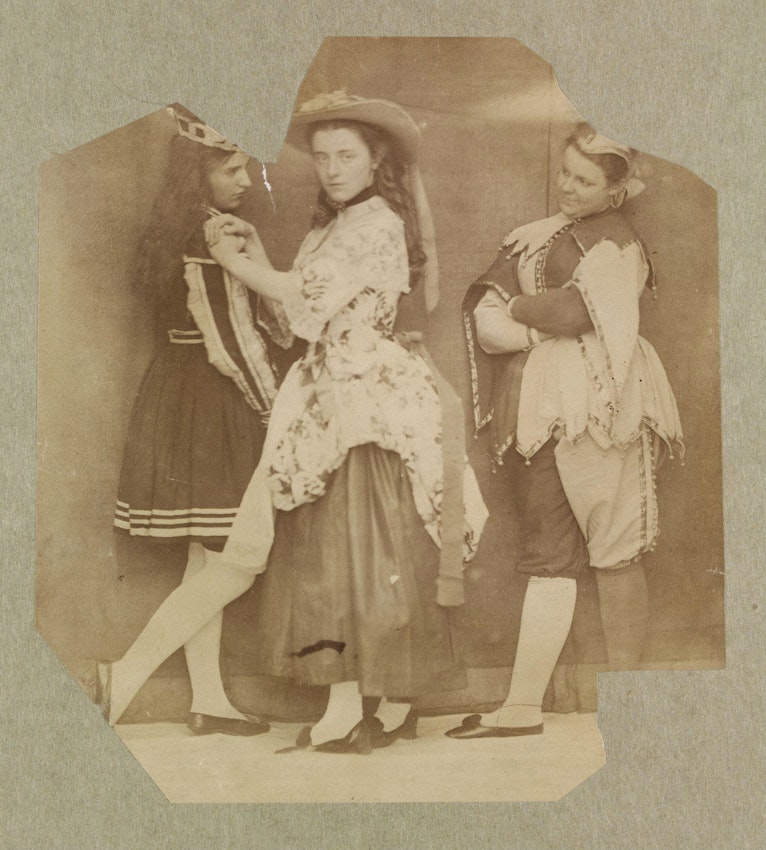 Scroll through the whole page to download all images before printing.
Scroll through the whole page to download all images before printing.Photograph of Clementina Hawarden’s daughters, Clementina (left), Isabella Grace (middle), and Florence Elizabeth (right), taken in a photography booth at the Horticultural Gardens in South Kensington, London, 1864. They are dressed in harlequin and shepherdess fancy dress — Source.
It is a point worth emphasizing that Hawarden would have spent most of her adult life pregnant or with an infant in arms. Nearly twenty years separate her eldest and youngest daughters, and it was in that fertile domestic landscape that Hawarden began experimenting with photography, no idle pastime but a labor-intensive process. The work of motherhood and photography were inextricable, as suggested by her surviving prints. In an 1854 letter, by which point Hawarden had five children, her uncle remarked on her maternal care: “I never saw nicer children or better brought up. . . . It seems strange [that] Clemy who could never keep her own shawl in order & whose devotion to her children seemed to spoil a whole generation, but her good sense and regard to duty has kept all right.”6
It is unknown why Hawarden decided to become a photographer, a laborious and messy pursuit that would have been an unusual undertaking for a woman of rank. Nor is it known when exactly Hawarden began taking photographs, or how she learned the complicated wet collodion process she preferred, but as Dodier notes, “the speed with which she became proficient is impressive.”7 The earliest surviving images are from 1857, taken at Dundrum House, the family’s estate in Ireland. Hawarden’s husband inherited Dundrum when he assumed his title in October 1856, making the couple some of the wealthiest landowners in the British Isles and drastically altering their financial circumstances. Dundrum features significantly in her early works: Hawarden took stereoscopic photographs of the landscape around the estate, perhaps suggesting an early interest in the medium's doubling effect that would define her mature art. Her early figural photography had an unsurprisingly amateurish quality, showing a photographer who was still learning the subtle manipulation of light and shadow. In many of these photographs, her family proved themselves eager models, dressing up as picturesque peasants and playing stock roles before her camera. Even their dogs had parts. As tableaux vivants, the images are charming records of an aristocratic family at play, but they show little of the sophisticated photographer who would emerge a few years later.
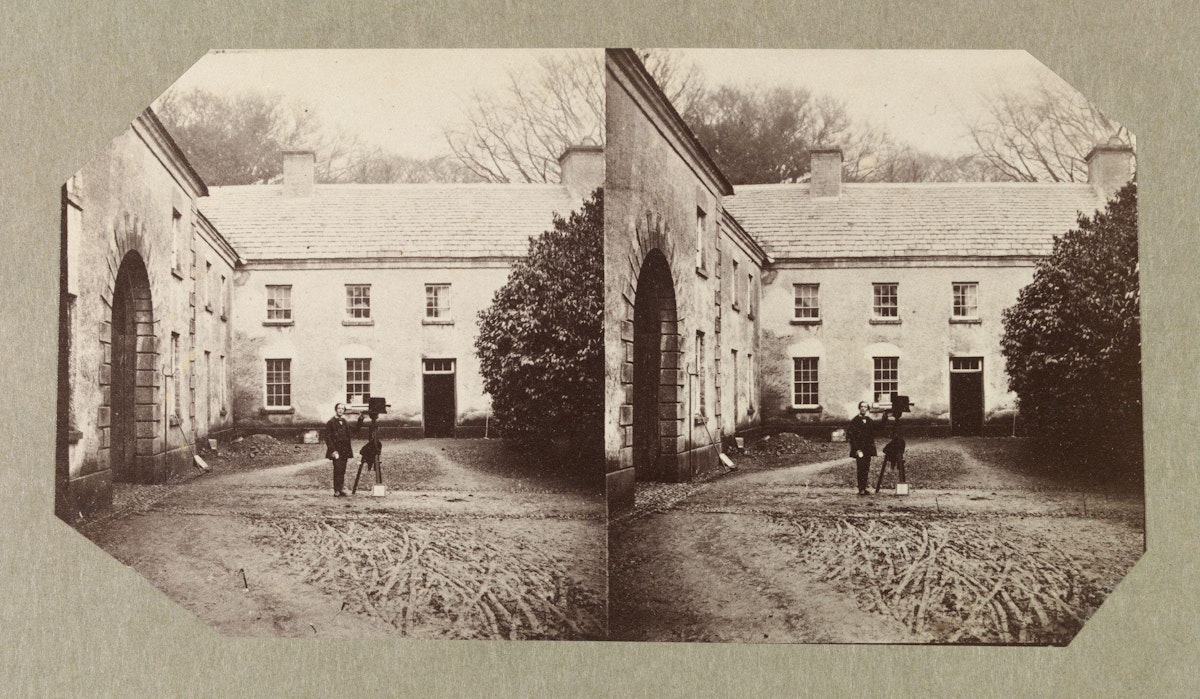 Scroll through the whole page to download all images before printing.
Scroll through the whole page to download all images before printing.Stereograph by Clementina Hawarden of the west wing of Dundrum House in County Tipperary, Ireland, ca. 1857–60. The man posing with a camera is unknown — Source.
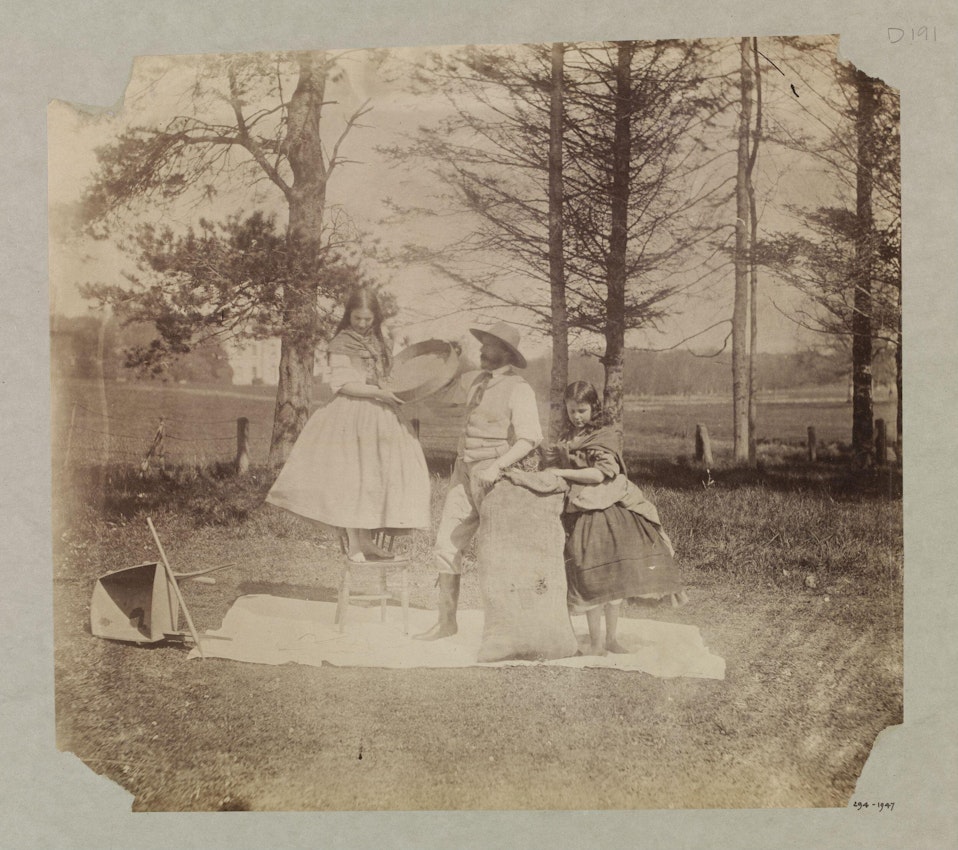 Scroll through the whole page to download all images before printing.
Scroll through the whole page to download all images before printing.Photograph by Clementina Hawarden of her daughters, Clementina and Florence, and husband, Cornwallis, enacting a peasant scene on the grounds of Dundrum House in County Tipperary, Ireland, ca. 1859–61— Source.
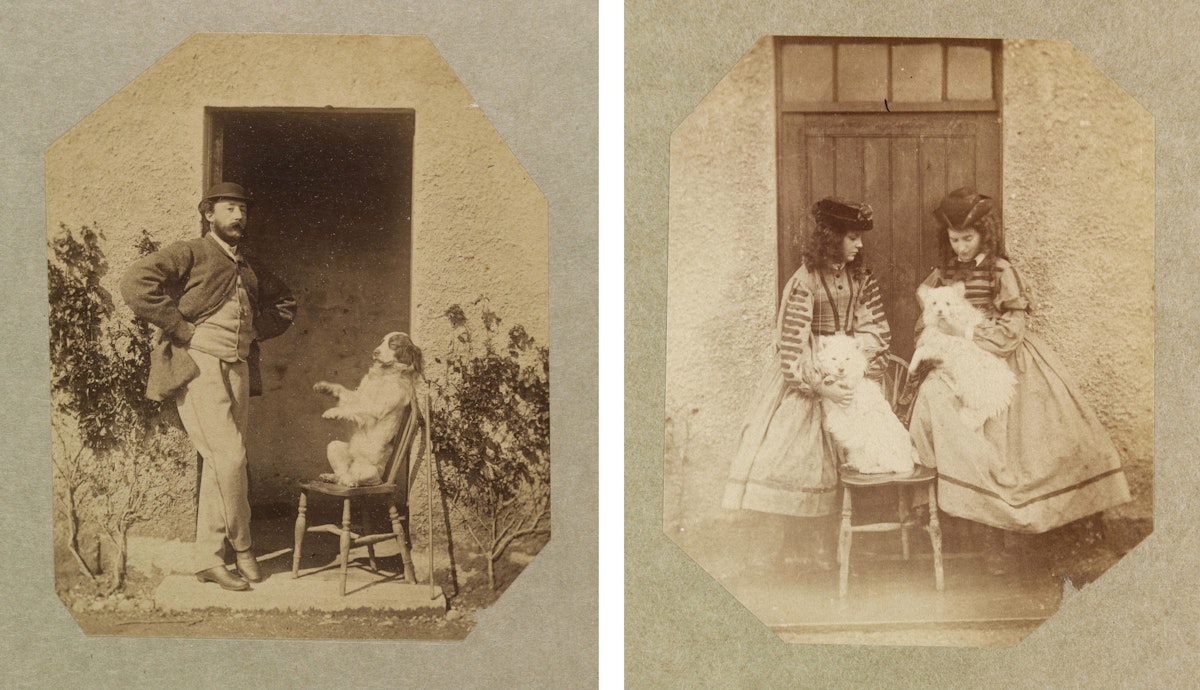 Scroll through the whole page to download all images before printing.
Scroll through the whole page to download all images before printing.Hints of Hawarden’s interest in mirroring began to appear in photographs she took of Clementina on the grounds of Dundrum. In one particularly compelling photograph, her daughter is outside, dwarfed by a massive tree, her body and face turned to offer the camera her profile. Clementina’s straight stance is mimicked by the tree’s trunk, even as one of the tree’s massive branches seems to purposefully bend to cradle and frame Clementina’s form. The contemplative pose, combined with Hawarden’s compositional coupling of her daughter and nature, conjures up the romantic tone of Thomas Gainsborough’s portraits from the previous century.
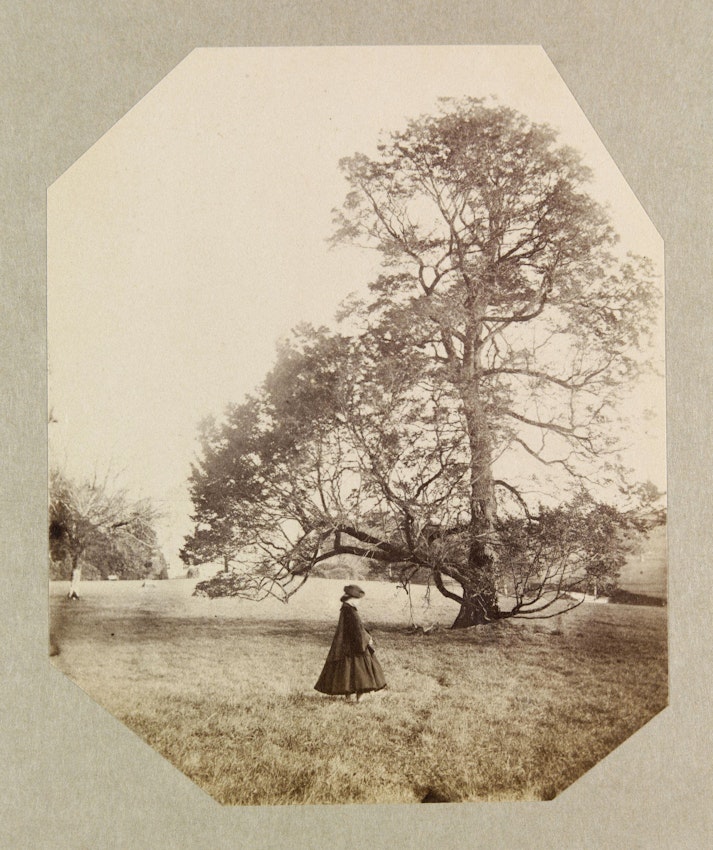 Scroll through the whole page to download all images before printing.
Scroll through the whole page to download all images before printing.Photograph by Clementina Hawarden of her daughter Clementina, taken by the Multeen river on their Dundrum House grounds in County Tipperary, Ireland, ca. 1858–61— Source.
In 1859, Hawarden and family moved to the newly constructed home in South Kensington. There, it seems, she was able to secure a governess for her children, giving her more time and space to devote to photography. She converted rooms on the second floor of the house into her studio and shifted primarily to indoor scenes. Although there are numerous photographs of her younger children, husband, and other relatives from 1859 until her death, her three eldest daughters stood most regularly in front of her camera’s lens.8
Hawarden, Isabella, Clementina, and Florence must have spent a significant amount of time in the studio, producing and posing for photographs. The space was innately gendered — one where a mother and her daughters collaborated, artfully arranging and costuming themselves. In Hawarden’s studio, “women”, Lindsay Smith writes in Politics of Focus, “play all the parts.”9 While the photographs might look like play, particularly the fancy dress scenes in which the narrative or inspirational source has been lost, producing a photograph was difficult and time-consuming. It seems that Hawarden’s daughters helped her develop her prints as well, laboring alongside their mother from conception to realization.
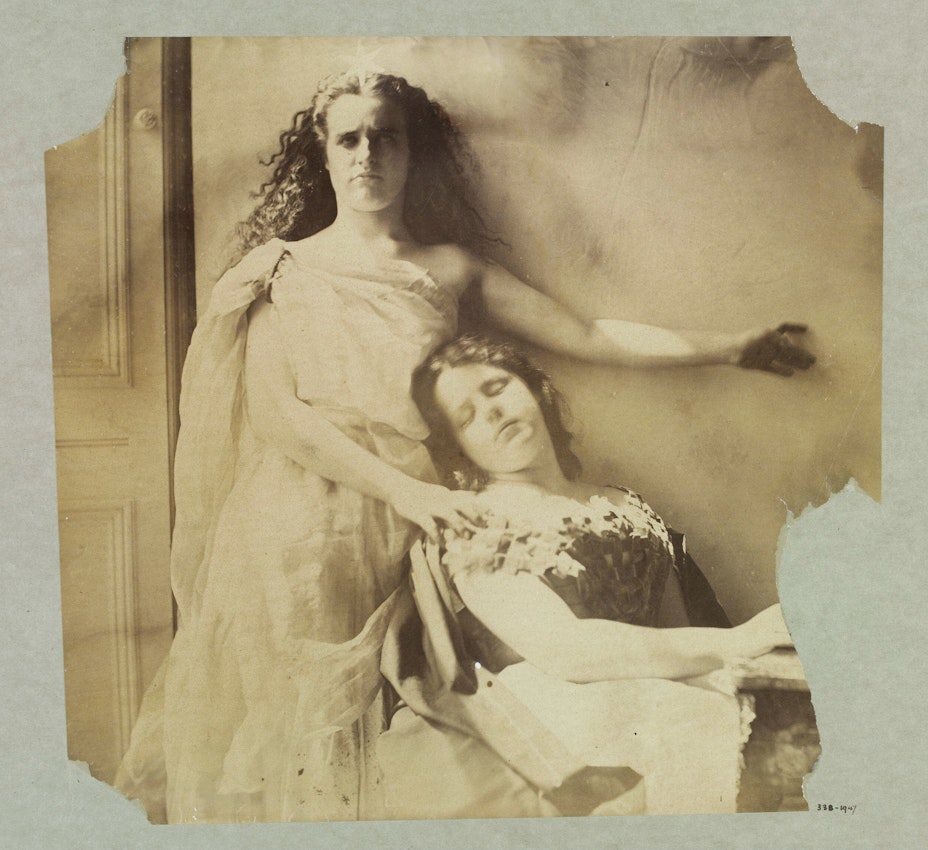 Scroll through the whole page to download all images before printing.
Scroll through the whole page to download all images before printing.Photograph by Clementina Hawarden taken at 5 Princes Gardens, London, of her daughters Clementina and Florence Elizabeth in fancy dress, ca. 1863–64 — Source.
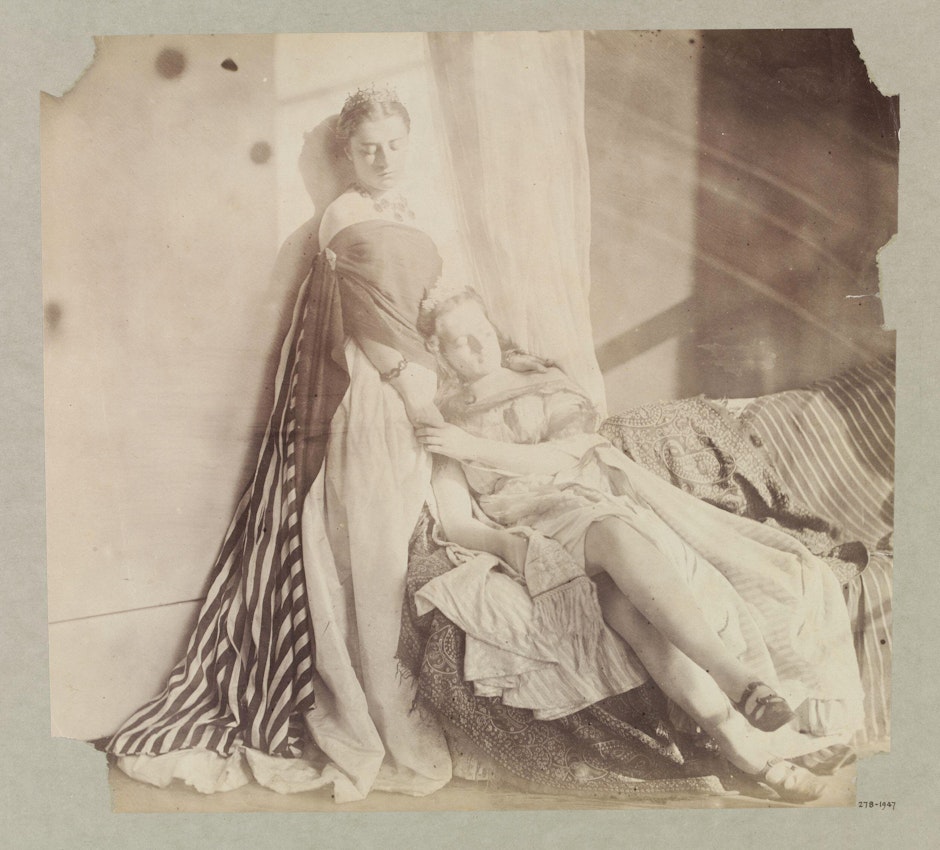 Scroll through the whole page to download all images before printing.
Scroll through the whole page to download all images before printing.Photograph by Clementina Hawarden taken at 5 Princes Gardens, London, of her daughters Isabella Grace and Clementina in fancy dress, ca. 1863–64 — Source.
She appears to have been exceptionally interested in posing her eldest daughters in front of mirrors — it was a motif she returned to repeatedly. Again and again, the photographs allude to the visual concept of doubling. In one particularly sophisticated example, taken between 1861–62, Hawarden captured Clementina gazing into the same full-length cheval mirror, hair bound to show her neck, a white blouse arranged to reveal a bare shoulder. The light from the balcony windows on Hawarden’s second-floor studio gives the photograph a tenebristic contrast, illuminating Clementina’s shoulder and the folds of her skirt while simultaneously throwing the reflection of her face into darkness. In 1863, after seeing Hawarden’s prints in an exhibition, a writer for the Photographic News remarked on Hawarden’s “darling lighting” and “artistic effects of light and shade”, comparing her manipulation of light to the techniques of Rembrandt.10
An attractive young woman gazing into a mirror is, of course, a recurring motif in the history of art. Venuses like Diego Velazquez’s gazed into mirrors and so did penitent Magdalens who warn viewers of the fleetingness of life. Painters were no doubt drawn to mirrors because of the visual tricks they could explore and, for artists like Velazquez, reflective glass allowed the painter to simultaneously show his attractive model from a variety of angles. For photographers in the nineteenth century, however, the mirror was rich with meaning about their very medium.
Since William Henry Fox Talbot published the six volumes of The Pencil of Nature (1844–46), describing his calotype photographs as “the agency of Light alone”, photography was perceived to be unique because it was anchored in its fidelity to detail. But Victorian photographers also understood that those very details — flattening and still — often rendered a photograph otherworldly. They dubbed the camera a “magic mirror”. As Susan Fagence Cooper writes, the description “not only commented on its mimetic accuracy but also its power to make the once-familiar mirror image strangely unfamiliar, the site of definition oppositions, inversions, and ‘realistic’ apparitions.”11 In Oscar Rejlander’s composite print, The Infant Photography Giving the Painter an Additional Brush (ca. 1856), his allegorical representation of photography features a mirror in which Rejelander and his camera are shown in reflection. Rejlander weds the reproductive effects of the mirror with the medium of photography itself.
 Scroll through the whole page to download all images before printing.
Scroll through the whole page to download all images before printing.Oscar Gustave Rejlander, “The Infant Photography Giving the Painter an Additional Brush”, ca. 1856 — Source.
If Rejlander made plain the link between mirror and photography, then Hawarden’s formal interest in coupling her daughters with mirrors added yet another layer to the allegory: reproduction extends not just to the photograph but to Hawarden’s subjects. In two separate photographs of Clementina, both taken sometime between 1862 and 1863, she leans against the full-length mirror, her right arm supporting her elegant, nearly balletic contrapposto. In both she wears her underclothes; in one photograph she is barefoot emphasizing her state of undress. Though Clementina is shown from a variety of angles, her contemplative gaze resists the camera, as if she is too absorbed to notice its presence, grounding the image in the domestic sphere, a space that, for Hawarden, was also a working photography studio. As Smith has written regarding Hawarden’s photographic panoply of women, the “innocuous scenes of domestic contemplation represent a profound questioning of all that the seemingly knowable domestic sphere stands for in Victorian culture.”12 Hawarden’s photographs are saturated with a sense of strange unknowability, as that magic mirror of photography’s fidelity becomes something almost spectral.
It seems likely that the photographs were taken in the same session since their only substantial differences are shoes, lighting, and the placement of a “negligee, blouse or peignoir” dangling on the mirror. Between these two photographs, Hawarden has posed and reposed her daughter, wedging her between the window and mirror emphasizing the structural tension of the photograph itself; she is posed between light and reproduction. “The mirror”, Craig Owens wrote in his pivotal essay “Photography ‘en abyme’”, “doubles the subjects—which is exactly what the photograph itself does—it functions as a reduced, internal image of the photograph.”13
In these two photographs, Hawarden has angled the mirror away from her camera; its reflection only captures Clementina and a vague impression of the window. It is as if she has purposefully removed any trace of herself. And yet, proof of her “authorship” is tangibly evident in the photograph: Clementina exists, she stands before the camera. This doubling of the meaning of reproduction — underscoring Hawarden’s role as both biological and artistic creator — haunts her photographs: it is evident in her use of mirrors, in a possibly disembodied hand reflected in a mirror, and in her loving focus on her daughters.
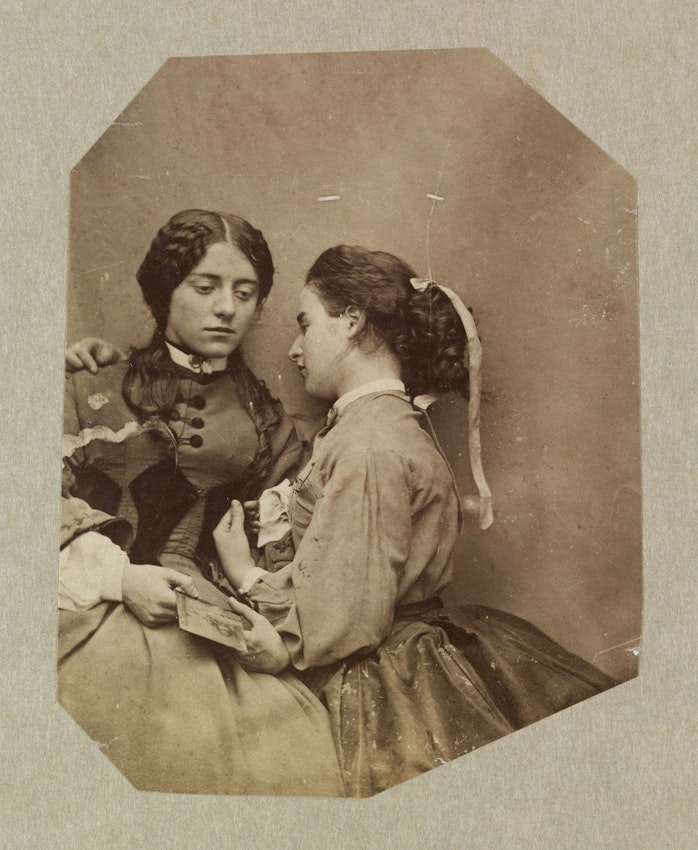 Scroll through the whole page to download all images before printing.
Scroll through the whole page to download all images before printing.Photograph by Clementina Hawarden of her daughters Clementina and Isabella Grace taken at 5 Princes Gardens, London, 1861–62 — Source.
In another poignant portrait, this time featuring both Isabella and Clementina, the two sisters are pressed close together, and Clementina wraps her arm around Isabella’s shoulders in a moment of unguarded intimacy. Isabella sits facing the camera while Clementina is captured in profile. They form a reflection of one another; similar to the angles that would reflect in the studio’s full-length mirror. Isabella holds in her hand a photograph (perhaps an image of another sister) undoubtedly taken by her mother. Here again, Hawarden’s hand haunts just outside the photographic frame. A photograph within a photograph, the daughters who worked with their mother to create these images and ensured their material survival.
After Hawarden’s quick and unexpected death from pneumonia, her photographs were gathered and pasted into an album for safekeeping, likely by one of her daughters since album-making was the province of women. It was passed to her granddaughter and the photographs remained unseen by the public for decades, eventually forgotten. Her granddaughter, Lady Clementina Tottenham, gifted nearly eight hundred of Hawarden’s photographs to the Victoria and Albert Museum in 1939.14 The edges of the photographs are torn because, at some point, they were ripped out of the album. That Hawarden’s photographs continue to exist is a testament to a different kind of women’s work, that of reproducing knowledge through preservation and memory. Though the torn edges add to the enigmatic mood of Hawarden’s images, they are also persistent reminders that women “collect and keep photographs”, as Rosalind Coward observed, “guardians of the unwritten history of the family.”
Stassa Edwards is a writer and editor. Her writing has appeared in numerous outlets, including Lapham's Quarterly, Aeon, Cabinet, Dwell, and Slate.





